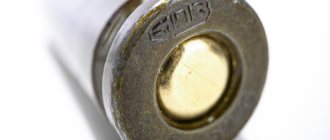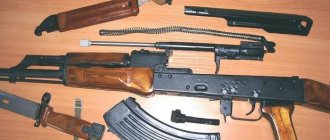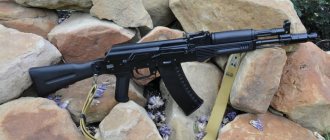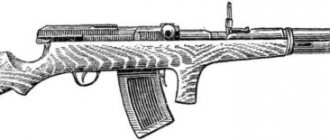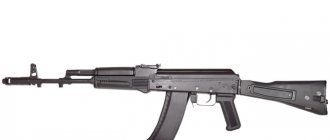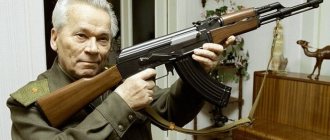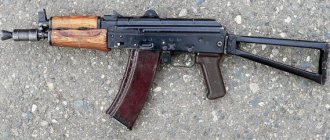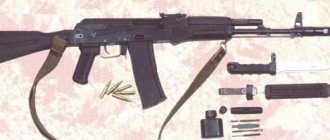Home | Weapons | Assault rifles | Russia / USSR | Kalashnikov assault rifle AK-74 / AKS-74
Kalashnikov AK-74 assault rifle
Kalashnikov AKS-74 assault rifle with folded stock
AK-74 with a GP-25 grenade launcher. Photo (c) KardeN
Automatic carbine AK-74 (GRAU Index - 6P20) 5.45 mm caliber, developed in 1970 by designer M.T. Kalashnikov, was adopted by the USSR armed forces in 1974. It is a further development of the AKM.
In the 1970s, following the NATO countries, the USSR followed the path of transferring small arms to low-impulse cartridges with reduced-caliber bullets to lighten the wearable ammunition (for 8 magazines, a 5.45 mm caliber cartridge saves 1.4 kg) and reduces , was considered to have “excessive” power of the 7.62 mm cartridge. In 1974, a weapon complex chambered for 5.45×39 mm was adopted, consisting of an AK-74 and an RPK-74 light machine gun, and subsequently (1979) supplemented by the small-sized AKS-74U, created for use in a niche that Western armies were occupied by submachine guns, and in recent years by the so-called PDW.
Main differences from its predecessor
- a new cartridge of 5.45×39 mm caliber (instead of 7.62×39 mm), which has a flatter bullet trajectory, which led to an increase in the direct shot range by 100 meters, and is also lighter (weight savings of 1.4 kg when carried ammunition in 8 magazines);
- a new muzzle brake-compensator, which serves to increase combat accuracy and reduce recoil energy;
- The magazine is made of light and durable plastic.
For assault rifles produced in 1974-1986, the butt and fore-end are made of wood. Since 1986, they began to be made from black plastic. Longitudinal grooves were made on the wooden butt on both sides to lighten the overall weight of the machine gun. They continue to be made on plastic stocks.
Can be used with the GP-25 or GP-30 or GP-34 underbarrel grenade launcher.
The accuracy of automatic fire has improved almost 2 times compared to the AKM (in linear dimensions). The accuracy of a single fire is approximately 50%.
The effective firing range of the AK 74 is:
For single ground and air targets - 500 meters;
For ground group targets - 1000 meters.
Direct shot range:
- According to the chest figure - 440 meters;
- His height is 625 meters.
How the invention of the century came about
Mikhail Kalashnikov was interested in invention from an early age, and made his first military developments before the Great Patriotic War, when he served in tank forces. In particular, he created an original design for pistol shooting from a tank. And the idea of creating a light, fast-firing and easy-to-use automatic weapon came to him during a forced break in service - in August 1941, tanker Kalashnikov was wounded and ended up in the hospital. As he later wrote in his memoirs, “the Germans are to blame for the fact that I became a military designer.”
Mikhail quickly fills in the gaps in knowledge and, during his rehabilitation leave, begins to create his first submachine gun. With it, he reaches the stage of shooting tests. The weapon does not pass tests, but Kalashnikov gains valuable experience of getting acquainted with samples of modern small arms, studies their design and testing methods, and communicates with weapons specialists.
Historians consider the starting point for the appearance of the Kalashnikov assault rifle to be July 15, 1943, when at a meeting of the People's Commissariat of Defense it was decided to create a new cartridge of reduced power with a 7.62 mm caliber and an assault rifle for it. A large number of designers took part in the competition, but Mikhail Kalashnikov began work only in mid-1945.
In the fall of 1946, with great help from the team of Kovrov Plant No. 2, Kalashnikov assembled three prototypes, designated by designer and year of creation as AK-46. The Kalashnikov assault rifle, together with the developments of designers Dementyev and Bulkin, is entering the second test round. It was during the modifications to the next stage of acceptance that revolutionary changes were made that made the legendary machine gun the way we know it today.
Normal combat requirements for AK74
- all four holes fit into a circle with a diameter of 15 cm at a distance of 100 m.
- the average point of impact deviates from the control point by no more than 5 cm in any direction.
Testing of combat is carried out by firing singles at a test target or a black rectangle 35 cm high and 25 cm wide, mounted on a white shield 1 m high and 0.5 m wide. Firing range - 100 m, position - lying down, without a bayonet, cartridges - with an ordinary bullet, scope - 3.
In general, one can note a significant improvement in the accuracy of fire compared to the AKM and especially the AK. As an example, consider the total median deviation at a distance of 800 m (vertical and width, respectively):
AK - 76 and 89 cm.
SKS - 47 and 34 cm.
AKM - 64 and 90 cm.
AK-74 - 48 and 64 cm.
AK equipment
When purchasing such a machine, many do not know that a kit also comes with it.
- So, as an accessory to the machine there is a special cleaning rod. It is simply necessary in order to promptly clean and lubricate the barrel, as well as other parts of the weapon.
- Wiping. This is a product that is used to clean or lubricate the bore.
- A brush is simply necessary in order to clean the canals from the inside thoroughly enough.
- The kit includes a special screwdriver, which is also called a hairpin. It is simply necessary if the machine is disassembled.
- And finally, a penalty. It is simply necessary in order to carefully store cleaning cloths, brushes, hairpins, screwdrivers, and other important components.
- Well, of course, an oil can, which is needed to lubricate the elements
Variants of the Kalashnikov assault rifle
AK-74 is the main option.
AKS-74 (GRAU Index - 6P21) - a variant of the AK74 with a triangular metal butt folding to the side. Created for use in airborne troops (an assault rifle with a non-folding stock cannot be conveniently and safely placed in the parachute suspension system).
AK-74N is a “night” version of the AK-74 with a side rail for attaching night sights.
AKS-74N is a “night” version of the folding AKS-74, with a side rail for attaching night sights.
AK-74M - AK74 modernized.
Ammo used
- 7N6 (1974, bullet with a steel core, lead jacket and bimetallic jacket).
- 7N10 (1992, bullet with increased penetration, with a heat-strengthened core). Armor penetration - 16 mm from a distance of 100 m.
- 7U1 (subsonic bullet for silent shooting).
- 7N22 (1998, armor-piercing bullet with a core made of high-carbon steel U12A by cutting with subsequent grinding of the ogival part). Armor penetration - 5 mm from a distance of 250 m (grade 2P), 1.9 times better than 7N6.
- 7N24 (increased manufacturing precision, heat-strengthened tungsten carbide core)
A bullet with a steel core of a 5.45 mm cartridge when fired from an AK74 provides the following penetrating effect [source not specified 1165 days]:
Penetration with a probability of 50% of steel sheets of thickness:
- 2 mm at a distance of 950 m;
- 3 mm at a distance of 670 m;
- 5 mm at a distance of 350 m.
Penetration with a probability of 80-90% of a steel helmet at a distance of 800 meters;
Penetration with a probability of 75-100% of body armor at a distance of 550 meters;
Penetration of 50-60 cm into a parapet made of dense compacted snow at a distance of 400 meters;
Penetration of 20-25 cm into an earthen barrier made of compacted loamy soil at a distance of 400 meters;
Penetration with a probability of 50% of a wall made of dry pine beams with a cross-section of 20x20 cm at a distance of 650 meters;
Penetration of 10-12 cm into brickwork at a distance of 100 meters.
In 1986, new bullets were developed with a heat-strengthened core of increased hardness, providing a significant increase in penetration: the new bullet pierces a steel helmet at a distance of 960 meters, and body armor with titanium plates at a distance of 200 meters.
Another improvement of the bullet in 1992 again increased armor penetration (the army body armor Zh85-T penetrates at a range of 200 m, and the heavy Zh95-K at a range of 50 m) with a constant initial speed. The new cartridge, which is 1.84 times superior in armor penetration to the 7N6, received the index 7N10. 7N10 provides penetration of 16 mm at a distance of 100 meters.
AK-74 assault rifle cartridge caliber 5.45 mm. Device. Rate of fire
AK-74 - Kalashnikov assault rifle, caliber 5.45 mm mod. 1974 (GRAU Index - 6P20) - a 5.45 mm caliber assault rifle, developed in 1970 by designer M. T. Kalashnikov and adopted by the USSR armed forces in 1974. It is a further development of the AKM. The development of the AK-74 is associated with the transition to a new low-pulse cartridge 5.45x39 mm. It was first used in the Afghan war, then in all conflicts in the post-Soviet space. Currently, this machine is used by most countries in Eastern Europe, as well as Asia.
Advantages
High reliability of operation in difficult conditions. Simplicity and low cost in production. In the AK-74M version - support for the installation of modern sighting and tactical devices, which is essentially a way to modernize the machine gun, and support for double-row box magazines similar to the Steyr AUG, made of impact-resistant plastic, with side inserts made of transparent polymer, for visual control of the amount of ammunition in the magazine .
Since one of the reasons for the creation of the AK-74 was a change in the caliber of the cartridge used by the machine gun, from 7.62x39 mm to 5.45x39 mm, the weapon has less recoil and, accordingly, greater shooting accuracy and a flatter bullet flight trajectory.
User manual
The design of the machine gun is largely the same as the AK-47, which made it easier to accept the new version.
The operating instructions imply standard maintenance of the machine gun and keeping it in good working order. There are also recommendations for troubleshooting problems that arise, many of which occur due to lack of maintenance.
For example, failure to feed a cartridge into the chamber occurs due to contamination or malfunction of the magazine. To eliminate it, reload the magazine; if it recurs, the cause is identified and eliminated.
Sticking of the cartridge, when the bullet rests against the breech end of the barrel, occurs due to a malfunction of the cartridge. In this case, holding the bolt handle, remove the cartridge. If repeated, change the store.
Misfire can also occur if the cartridge is faulty. In this case, repeat the previous steps. Also, a misfire may be based on a malfunction of the firing pin or firing mechanism. The cause is contamination and lack of lubrication.
This type of malfunction can be eliminated by disassembling and cleaning the trigger mechanism. If any breakdowns are detected, the machine is sent to a repair shop to replace parts.
If the cartridge case is not removed and the next cartridge is shorted, pay attention to contamination of the chamber, ejector, and its spring. In this situation, retract the bolt handle and, holding it, remove the magazine, the stuck cartridge and the cartridge case. After this, they reload and continue shooting; when jamming is repeated, they clean the chamber and ejector with the spring from dirt.
The bolt carrier does not move to the forward position due to wear or breakage of the return spring. In this situation, replacement of the part is required. In case of urgent need to continue shooting, the spring is deployed. This helps to partially restore the serviceability of the machine gun in combat conditions.
Taking into account all such requirements, the main recommendations for operation boil down to timely cleaning of the machine. This helps not only to avoid most problems, but also to detect wear and damage in time.
Flaws
Compared to the American M4A1 carbine, the AK-74 has lower single-fire accuracy.
In comparison with weapons with balanced automatics AEK-971, AK-107/AK-108, AK-74, the accuracy of firing bursts from unstable positions is 1.5-2 times lower.
The AK-74 lacks the ability to quickly change the barrel, like the FN SCAR, Steyr AUG, HK 416, and Bushmaster ACR; as well as a fixed-length burst firing mode, which was later added to the “hundredth series” assault rifles AK101-2, AK102-2, AK103-2, AK104-2, AK105-2.
The remaining advantages and disadvantages are similar to those for the entire AK family.
Technical characteristics of AKS-74
- Caliber: 5.45×39
- Weapon length: 940/700 mm
- Barrel length: 415 mm
- Weight without cartridges: 3.4 kg.
- Rate of fire: 600 rounds/min
- Magazine capacity: 30 rounds
Assault rifles
- Austria
- Brazil
- Czech
- South Korea
- South Africa
- France
- USA
- Singapore
- Spain
- Russia/USSR
- Australia
- Finland
- Germany
- Türkiye
- Switzerland
- Denmark
- Japan
- Israel
- Sweden
- Indonesia
- Belgium
- Poland
- Ukraine
- Italy
- Croatia
- Iran
- Dominican Republic
- Mexico
- Serbia
- Argentina
- China
- Canada
- Taiwan
- Great Britain
